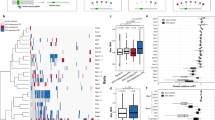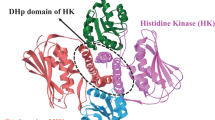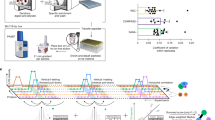Abstract
Most proteins that participate in cellular signalling networks contain modular protein-interaction domains. Multiple versions of such domains are present within a given organism1: the yeast proteome, for example, contains 27 different Src homology 3 (SH3) domains2. This raises the potential problem of cross-reaction. It is generally thought that isolated domain–ligand pairs lack sufficient information to encode biologically unique interactions, and that specificity is instead encoded by the context in which the interaction pairs are presented3,4. Here we show that an isolated peptide ligand from the yeast protein Pbs2 recognizes its biological partner, the SH3 domain from Sho1, with near-absolute specificity—no other SH3 domain present in the yeast genome cross-reacts with the Pbs2 peptide, in vivo or in vitro. Such high specificity, however, is not observed in a set of non-yeast SH3 domains, and Pbs2 motif variants that cross-react with other SH3 domains confer a fitness defect, indicating that the Pbs2 motif might have been optimized to minimize interaction with competing domains specifically found in yeast. System-wide negative selection is a subtle but powerful evolutionary mechanism to optimize specificity within an interaction network composed of overlapping recognition elements.
This is a preview of subscription content, access via your institution
Access options
Subscribe to this journal
Receive 51 print issues and online access
$199.00 per year
only $3.90 per issue
Buy this article
- Purchase on Springer Link
- Instant access to full article PDF
Prices may be subject to local taxes which are calculated during checkout




Similar content being viewed by others
References
Pawson, T. & Nash, P. Assembly of cell regulatory systems through protein interaction domains. Science 300, 445–452 (2003)
Saccharomyces Genome Database, 〈http://www.yeastgenome.org/〉.
Mayer, B. J. SH3 domains: complexity in moderation. J. Cell Sci. 114, 1253–1263 (2001)
Ladbury, J. E. & Arold, S. Searching for specificity in SH domains. Chem. Biol. 7, R3–R8 (2000)
Sparks, A. B. et al. Distinct ligand preferences of Src homology 3 domains from Src, Yes, Abl, Cortactin, p53bp2, PLCgamma, Crk, and Grb2. Proc. Natl Acad. Sci. USA 93, 1540–1544 (1996)
Kay, B. K., Williamson, M. P. & Sudol, M. The importance of being proline: the interaction of proline-rich motifs in signaling proteins with their cognate domains. FASEB J. 14, 231–241 (2000)
Cesareni, G., Panni, S., Nardelli, G. & Castagnoli, L. Can we infer peptide recognition specificity mediated by SH3 domains? FEBS Lett. 513, 38–44 (2002)
Zarrinpar, A., Bhattacharyya, R. P. & Lim, W. A. The structure and function of proline recognition domains. Science [online] (doi:10.1126/stke.2003.179.re8)
Lim, W. A., Richards, F. M. & Fox, R. O. Structural determinants of peptide-binding orientation and of sequence specificity in SH3 domains. Nature 372, 375–379 (1994)
Feng, S., Chen, J. K., Yu, H., Simon, J. A. & Schreiber, S. L. Two binding orientations for peptides to the Src SH3 domain: development of a general model for SH3-ligand interactions. Science 266, 1241–1247 (1994)
Schneider, T. D. Evolution of biological information. Nucleic Acids Res. 28, 2794–2799 (2000)
Posas, F. & Saito, H. Osmotic activation of the HOG MAPK pathway via Ste11p MAPKKK: scaffold role of Pbs2p MAPKK. Science 276, 1702–1705 (1997)
Tong, A. H. et al. A combined experimental and computational strategy to define protein interaction networks for peptide recognition modules. Science 295, 321–324 (2002)
Fazi, B. et al. Unusual binding properties of the SH3 domain of the yeast actin-binding protein Abp1: structural and functional analysis. J. Biol. Chem. 277, 5290–5298 (2002)
Park, S. H., Zarrinpar, A. & Lim, W. A. Rewiring MAP kinase pathways using alternative scaffold assembly mechanisms. Science 299, 1061–1064 (2003)
Orr, M. R. & Smith, T. B. Ecology and speciation. Trends Ecol. Evol. 13, 502–506 (1998)
Barnett, P., Bottger, G., Klein, A. T., Tabak, H. F. & Distel, B. The peroxisomal membrane protein Pex13p shows a novel mode of SH3 interaction. EMBO J. 19, 6382–6391 (2000)
Bottger, G. et al. Saccharomyces cerevisiae PTS1 receptor Pex5p interacts with the SH3 domain of the peroxisomal membrane protein Pex13p in an unconventional, non-PXXP-related manner. Mol. Biol. Cell 11, 3963–3976 (2000)
Huh, W.-K. et al. Global analysis of protein localization in budding yeast. Nature 425, 686–691 (2003)
Girzalsky, W. et al. Involvement of Pex13p in Pex14p localization and peroxisomal targeting signal 2-dependent protein import into peroxisomes. J. Cell Biol. 144, 1151–1162 (1999)
Sudol, M. From Src Homology domains to other signaling modules: proposal of the ‘protein recognition code’. Oncogene 17, 1469–1474 (1998)
Palmer, E. Negative selection—clearing out the bad apples from the T-cell repertoire. Nature Rev. Immunol. 3, 383–391 (2003)
Yaffe, M. B. et al. A motif-based profile scanning approach for genome-wide prediction of signaling pathways. Nature Biotechnol. 19, 348–353 (2001)
Newman, J. R. & Keating, A. E. Comprehensive identification of human bZIP interactions with coiled-coil arrays. Science 300, 2097–2101 (2003)
Kim, S. K. et al. A gene expression map for Caenorhabditis elegans. Science 293, 2087–2092 (2001)
Jiang, M. et al. Genome-wide analysis of developmental and sex-regulated gene expression profiles in Caenorhabditis elegans. Proc. Natl Acad. Sci. USA 98, 218–223 (2001)
Maxwell, K. L. & Davidson, A. R. Mutagenesis of a buried polar interaction in an SH3 domain: sequence conservation provides the best prediction of stability effects. Biochemistry 37, 16172–16182 (1998)
Lim, W. A., Fox, R. O. & Richards, F. M. Stability and peptide binding affinity of an SH3 domain from the Caenorhabditis elegans signaling protein Sem-5. Protein Sci. 3, 1261–1266 (1994)
Kwok, P. Y. & Duan, S. SNP discovery by direct DNA sequencing. Methods Mol. Biol. 212, 71–84 (2003)
Lim, W. A. & Richards, F. M. Critical residues in an SH3 domain from Sem-5 suggest a mechanism for proline-rich peptide recognition. Nature Struct. Biol. 1, 221–225 (1994)
Acknowledgements
We thank A. Davidson and members of the Davidson laboratory, I. Herskowitz, P. Y. Kwok, E. O'Shea, A. Sali, K. Yamamoto, R. Zuckerman, P. Chien, K. Chak, R. Bhattacharyya, J. Dueber, N. Sallee, B. Yeh, and members of the Lim laboratory for assistance and discussion. This work was supported by grants from the NIH and the Packard Foundation. S.-H.P. is a Jane Coffin Child Fellow. A.Z. is supported by the UCSF Medical Scientist Training Program.
Author information
Authors and Affiliations
Corresponding author
Ethics declarations
Competing interests
The authors declare that they have no competing financial interests.
Rights and permissions
About this article
Cite this article
Zarrinpar, A., Park, SH. & Lim, W. Optimization of specificity in a cellular protein interaction network by negative selection. Nature 426, 676–680 (2003). https://doi.org/10.1038/nature02178
Received:
Accepted:
Issue Date:
DOI: https://doi.org/10.1038/nature02178
This article is cited by
-
Engineering broad-spectrum inhibitors of inflammatory chemokines from subclass A3 tick evasins
Nature Communications (2023)
-
Impact of the Synthetic Scaffold Strategy on the Metabolic Pathway Engineering
Biotechnology and Bioprocess Engineering (2023)
-
Protein context shapes the specificity of SH3 domain-mediated interactions in vivo
Nature Communications (2021)
-
Gene networks that compensate for crosstalk with crosstalk
Nature Communications (2019)
-
Programmable design of orthogonal protein heterodimers
Nature (2019)
Comments
By submitting a comment you agree to abide by our Terms and Community Guidelines. If you find something abusive or that does not comply with our terms or guidelines please flag it as inappropriate.



